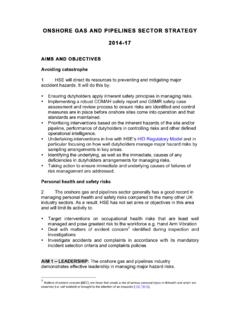Transcription of Setting aims and objectives - Red Ochre
1 Setting aims and objectives What are aims and objectives and why are they important? aims and objectives help you to define where you want to be strategically and how you are going to get there in practice. They allow you and your team to understand and communicate clearly what your social enterprise is all about and they create a focus that clarifies and energises your motivation. Defining aims and objectives is extremely important for social enterprises because they are trying to create added value through social and environmental impact, as well as profit. Your aim should be a short but general statement of intent about why your social enterprise exists and what it is set up to achieve in the long term.
2 Organisations tend to have one overall aim but some social enterprises also have a set of more specific aims which help to explain the general statement in more detail (see the diagram below). Your objectives are very specific statements that define the practical steps you will take to achieve your aim(s). objectives are about what your social enterprise is intending to do in the short to medium term and how it is going to create change. Good objectives should be SMART: Specific - you should know when an objective has been reached by making it as definite as possible Measurable - you should be able to measure whether the objective has been achieved Attainable - the target must be possible to achieve Relevant - it should form part of the business's overall aim Time-related - the objective should be achieved in a specified time period The diagram below gives you examples of an overall aim, specific aims and objectives for a social enterprise providing training and advice to young refugees: Source: Big Lottery Fund Business Link in London 2009 Web: Email: Enquiry Line.
3 0845 6000 787 How do you identify, create and review aims and objectives ? Your aims and objectives can be built around social, environmental or economic issues, or a combination of these. It really depends on what success looks like to you and how you intend to make it happen (for further information you can also see our guide on defining success and the triple bottom line). Creating and reviewing your aims and objectives is a strategic exercise that will ensure there is clarity internally (between your team, your board, your volunteers) and externally (amongst your partners, beneficiaries, customers, investors and other stakeholders). The clarity will be around why you do what you do (your aim), what you do and how you do it (your objectives ).
4 Clear aims and objectives are meant to be practical statements that can help focus your enterprise s priorities at a strategic and operational level. If you haven t got aims and objectives , you can identify them by asking yourself a few simple questions. If appropriate, it is useful to involve your team members or other stakeholders in identifying or reviewing your aims and objectives . Your beneficiaries, customers and key influencers may have an interesting or different perspective about what your organisation does and how it does it. To identify or review your aim(s): What does success look like to you? What is your social enterprise trying to create, improve or change?
5 What are the wider problems or issues you are trying to address? What is the big need you are trying to meet? What are your business and financial aims ? To identify or review your objectives : What practical things are you going to do to make the above happen? When will these be done? What services, activities or products are you going to offer? Who will you offer them to? How are you going to create change? How will you know that this has been achieved? Can you use targets to quantify or measure progress towards your aim(s)? How will you promote your achievements? For example, the overall strategic aim of Divine Chocolate Ltd ( ) is: To improve the livelihood of smallholder cocoa producers in West Africa by establishing their own dynamic branded proposition in the UK chocolate market, thus putting them higher up the value chain.
6 To achieve this mission a range of clear intermediate objectives were set: to take a quality and affordable range of Fairtrade chocolate into the UK mainstream market to pay a Fairtrade price for all the cocoa used in the chocolate sold to raise awareness of fair trade issues among UK retailers and consumers of all age groups to be highly visible and vocal in the chocolate sector and thereby act as a catalyst for change to be the leading Fairtrade chocolate company Things to look out for when presenting your aims and objectives aims versus objectives People often confuse aims and objectives and although they are complementary they are very different. Remember that your aim is why you do it, while your objectives are how and what you do to achieve this aim.
7 aims and objectives versus vision and mission aims and objectives are also closely related to an organisation s vision and mission. The vision can be a captivating way that an organisation expresses its overall aim to its stakeholders in order to inspire and Business Link in London 2009 Web: Email: Enquiry Line: 0845 6000 787 Business Link in London 2009 Web: Email: Enquiry Line: 0845 6000 787 stand out from the crowd. It needs to sound exciting whilst also being realistic and it should be contained within a short and concise statement (on your marketing material or website, for example). Similarly, the mission is a practical statement which communicates how an organisation intends to meet this vision, thus summarising your many objectives with clarity and simplicity.
8 The vision and mission of an organisation are usually simple, memorable, inspiring and aspirational statements that are published to communicate your organisation s dreams, aims and objectives to the world. aims and objectives are often used as more practical strategic statements about the enterprise; some organisations choose to keep these internally for management purposes. Here s an example from the Parent s Advice Centre, who have decided to have a distinct vision, mission and aim on their website: their vision is that all parents and family work professionals will have access to programmes which can enhance their knowledge, skills and confidence their mission is to provide relevant and informative parenting programmes throughout Northern Ireland their aim is to enhance the quality of family life by supporting and empowering parents and the professionals who work with them Some social enterprises will feel that their vision and overall aims are the same this is not a problem and there is no need to write two different statements if one can do the job.
9 However, make sure that all these are jargon-free. Final thought Clear and up-to-date aims and objectives are also very important for monitoring and evaluation and for understanding and measuring your social impact. Your aim can be measured in terms of the outcomes (the big change you are making) and your objectives in terms of the outputs (the specific intermediary achievements). Further information Read our guide on identifying your stakeholders: Read our guide on monitoring and evaluation: Read our guide on understanding and measuring social impact: Read our guide on vision, mission and values: Read our guide on defining success and the triple bottom line: Read our guide on beneficiaries, customers and key influencers.








